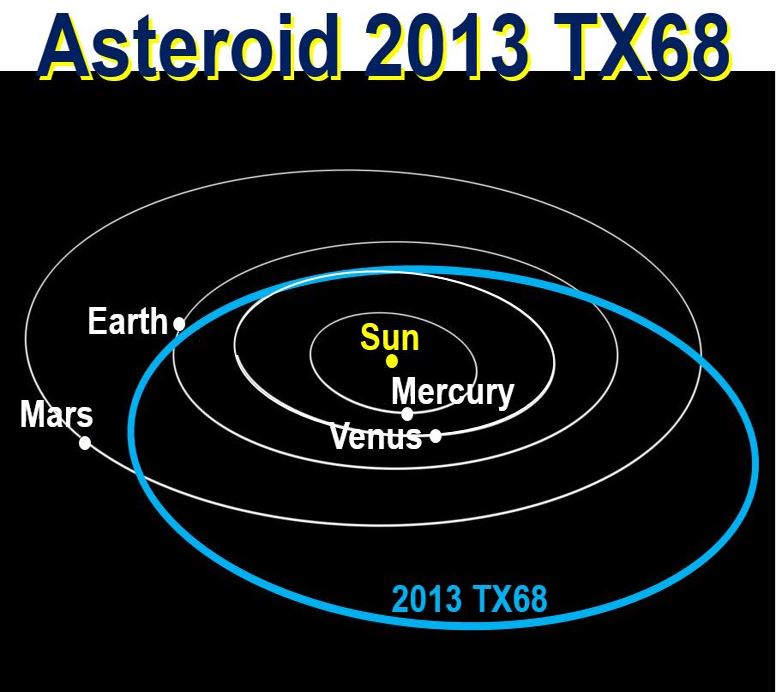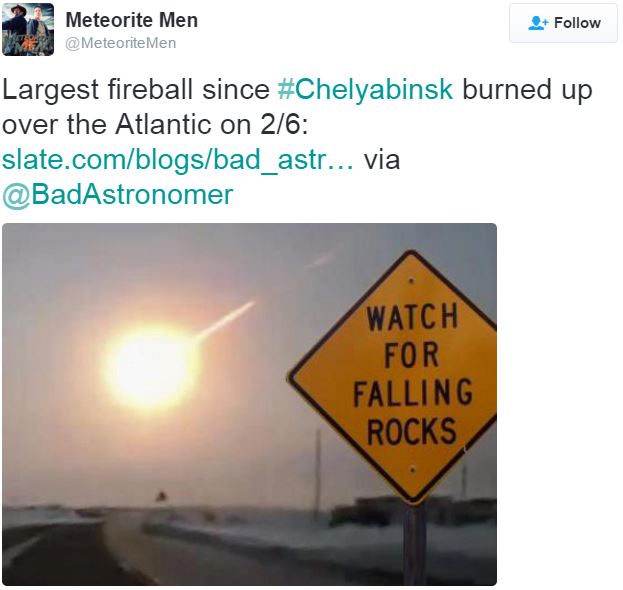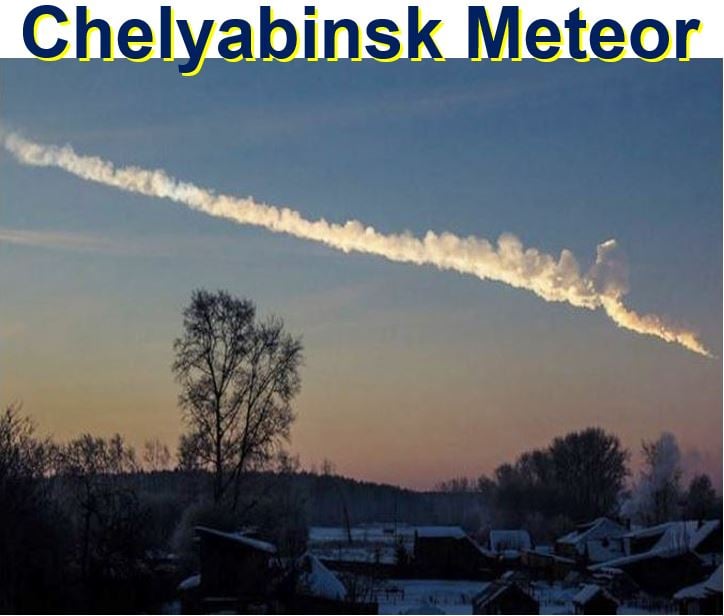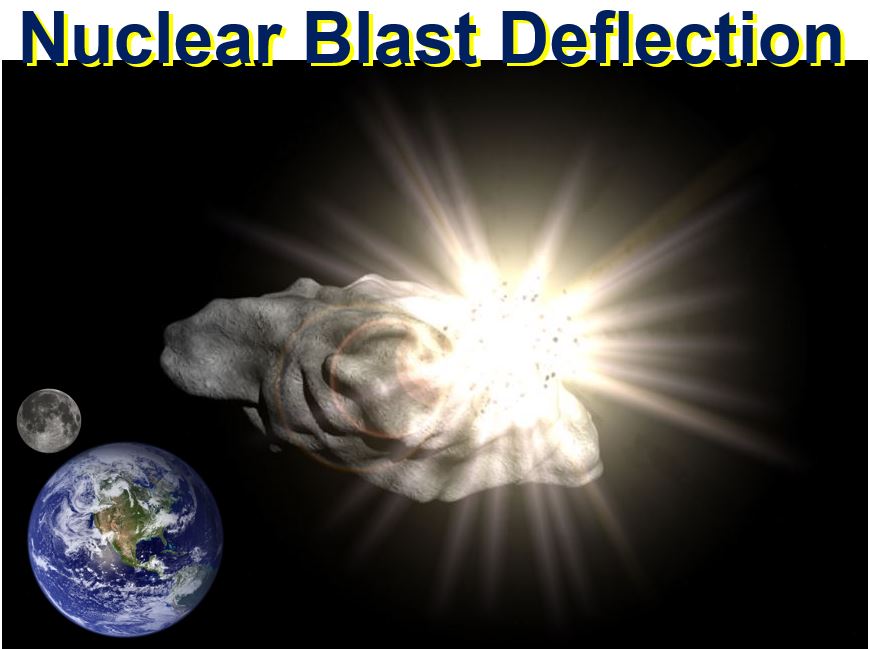Asteroid 2013 TX68, which is 100 feet wide, could crash into us although it is highly unlikely, says NASA after having a rethink and changing its mind. The asteroid is scheduled for a very close flyby on 28th September, 2017, and a less-close one on March 8th, 2016.
The good news is that the ‘no chance’ to ‘chance’ of a collision with Earth is very remote – a 1 in 250 million possibility, NASA calculates.
Even so, that is still a possibility. If 250,000,000 EuroMillions lottery tickets are sold, there is usually one winner. So, the likelihood that a killer-asteroid might crash into us next year is about the same as winning that lottery – it could happen.
 Asteroid 2013 TX68’s orbit compared to Earth’s. Is a 1-in-250-million chance so insignificant we should not worry? Probably, unless you won the EuroMillions lottery once! (Image: www.nasa.gov)
Asteroid 2013 TX68’s orbit compared to Earth’s. Is a 1-in-250-million chance so insignificant we should not worry? Probably, unless you won the EuroMillions lottery once! (Image: www.nasa.gov)
Is 100 ft wide a killer asteroid?
The Chelyabinsk meteor, a superbolide that exploded at a height of about 18.4 miles or 97,400 feet (29.7 km), on 15th February, 2013, was 20 metres (65.6 feet) wide. The explosion occured just north of the Russian city of Chelyabinsk.
A total of 7,200 buildings in six cities across the region were damaged by the explosion’s shockwave and 1,500 people had serious-enough injuries to seek medical help in hospital.
If a 65-feet-wide object can do that, then ‘Yes’, a 100-ft-wide asteroid has the potential to kill people and cause severe damage.
Imagine what the damage and loss of life would be if 2013 TX68 were to explode above a densely-populated area – for example, above New York, London, Mexico City or Shanghai. Loss of life and damage to property, plus the mass panic it would cause, would be colossal.
 Earlier this month, a fireball exploded over the Atlantic Ocean with the force of 13000 tons of TNT. It was the most powerful event since the 2013 Chelyabinsk blast. As the explosion occurred 620 miles off the coast of Brazil, hardly anybody noticed it. (Image: twitter.com/MeteoriteMen)
Earlier this month, a fireball exploded over the Atlantic Ocean with the force of 13000 tons of TNT. It was the most powerful event since the 2013 Chelyabinsk blast. As the explosion occurred 620 miles off the coast of Brazil, hardly anybody noticed it. (Image: twitter.com/MeteoriteMen)
NASA contradicts itself
In what appears to be a slightly contradictory coment, NASA wrote on its website on 25th February:
“Scientists at NASA’s Center for NEO Studies (CNEOS) at the Jet Propulsion Laboratory in Pasadena, California, have determined there is no possibility that this object could impact Earth during the flyby next month.”
“But they have identified an extremely remote chance that this small asteroid could impact on Sep. 28, 2017, with odds of no more than 1-in-250-million. Flybys in 2046 and 2097 have an even lower probability of impact.”
The two terms ‘there is no possiblity’ and ‘odds of no more than a 1-in-250-million’ should not really go together in one announcement, should they?
2013 TX68 is expected to do a near Earth flyby on 8th March, 2016, but on that occasion it will be further away than in September 2017, scientists predict.
If it did hit Earth, NASA estimates that it would probably produce an air burst with about double the energy of the Chelyabinsk event in 2013.
 Chelyabinsk fireball trail. According to the European Space Agency: “An object entered the atmosphere over the Urals early in the morning of 15 February 2013. The fireball exploded above Chelyabinsk city, and the resulting overpressure caused damage to buildings and injuries to hundreds of people. This photo was taken by Alex Alishevskikh from about a minute after noticing the blast.” (Image: esa.int/spaceimages)
Chelyabinsk fireball trail. According to the European Space Agency: “An object entered the atmosphere over the Urals early in the morning of 15 February 2013. The fireball exploded above Chelyabinsk city, and the resulting overpressure caused damage to buildings and injuries to hundreds of people. This photo was taken by Alex Alishevskikh from about a minute after noticing the blast.” (Image: esa.int/spaceimages)
Nuking killer asteroids in advance
Space agencies across the world are looking at the possibility of using nuclear weapons to shift killer asteroids’ trajectories that appear to be Earth-bound so that they would miss our planet.
In January this year, the EU Commission announced that it was tasking a team of Russian scientists to find out how effective atomic bombs would be to reduce the threat of killer asteroids.
A nuclear bomb would explode either on or very close to the celestial body, causing its outer layers to evaporate – this would push it off course, thus making it miss Earth. The mission will form part of the NEOShield Project.
The NEOShield (Near Earth Object Shield) Project is an international collaboration involving 13 partners from industry and research institutions. The EU Commission granted NEOShield FP7 funding in 2014, to find ways of preventing impacts from threatening NEOs, using space-based deflection technologies.
 According to neoshield.net, a nuclear blast deflection “Requires the use of a nuclear explosive close to an asteroid. The blast causes the outer layers of the asteroid to evaporate, acting just like rocket fuel, pushing the asteroid away from Earth. This is very different to the usual picture used in Hollywood of asteroids being blown up. It’s thought to be a much safer and more effective way of safeguarding the Earth.” (Image: neoshield.net)
According to neoshield.net, a nuclear blast deflection “Requires the use of a nuclear explosive close to an asteroid. The blast causes the outer layers of the asteroid to evaporate, acting just like rocket fuel, pushing the asteroid away from Earth. This is very different to the usual picture used in Hollywood of asteroids being blown up. It’s thought to be a much safer and more effective way of safeguarding the Earth.” (Image: neoshield.net)
NASA says NEOs are comets and asteroids whose trajectories have been ‘nudged’ by the gravitational attraction of nearby planets into orbits that bring them into Earth’s neighbourhood.
Throughout Earth’s history, there have been thousands and possibly millions of major collisions. They have played a key role in forming the planets that today orbit the Sun.
Asteroids and comets also brought organic materials and water – which were essential for the development of life – to the early Earth.
However, as well as contributing to life on our planet, these celestial bodies have also played a major role in mass extinctions. Today they pose a small – but significant – threat to human life, and perhaps the very survival of our species.
Scientists from the United States, the European Union, Russia, China and Japan say that major collisions with asteroids and comets will continue happening at unpredictable, irregular intervals in the future.
Thousands of NEOs out there
As a result of targeted efforts and more sophisticated observing techniques, thousands of NEOs have been discovered since the beginning of this century, and their real threat for Earth has been laid bare.
Compared to what has hit our planet in the past, the Chelyabinsk event was fairly minor. Sixty-five million years ago a major impact caused the extinction of dinosaurs.
According to the European Commission:
“The potentially devastating effects of an impact of a large asteroid or comet are now well recognized, although we can only speculate on the complex disruptive effects a major impact would have on today’s technically sophisticated and highly networked world.”
Video – Asteroid 2013 TX68
When the asteroid does a flyby on March 8th, it is expected to be between 11,000 miles (17,000 km) and 9 million miles (14 million km) from Earth. The wide variation in possible closest approach distances is because scientists have not known about it for long, and thus cannot make super-accurate predictions.

